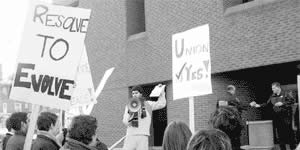|
|
|
|
|
GEO Throws Down the
Gauntlet
by Ben Scott
 The
events of March 13, 2002, marked a sea change in the movement
for labor rights at the University of Illinois, led by
the actions of the Graduate Employeesí Organization
(GEO). At 7:45 that morning, forty-one GEO members and
supporters entered Swanlund Administration Building to
stage a peaceful protest. Within minutes, the activists
occupied the building and blocked the doorways, preventing
any further access by university staff or administrators.
They ran through the halls, distributing chocolates and
statements of purpose to individuals already at their
desks, including Chancellor Nancy Cantor and Vice Chancellor
Charles Colbert. The
events of March 13, 2002, marked a sea change in the movement
for labor rights at the University of Illinois, led by
the actions of the Graduate Employeesí Organization
(GEO). At 7:45 that morning, forty-one GEO members and
supporters entered Swanlund Administration Building to
stage a peaceful protest. Within minutes, the activists
occupied the building and blocked the doorways, preventing
any further access by university staff or administrators.
They ran through the halls, distributing chocolates and
statements of purpose to individuals already at their
desks, including Chancellor Nancy Cantor and Vice Chancellor
Charles Colbert.
During the first hour, tension levels escalated as administrators
scrambled to assess the situation and decide upon a course
of action. By 9 a.m., Chancellor Cantor and the remaining
Swanlund workers had departed to makeshift workspaces
in other buildings. Their departure was serenaded by the
chanting of the picket line, the contingent of GEO activists
who had not entered the building. Armed with a megaphone,
a guitar, and sloganed placards, these supporters kept
up a marching public presence on the sidewalk in front
of Swanlund throughout the day.
"Our demand was simple," recalled GEO Co-President
Uma Pimplaskar in a speech at the GEO membership meeting
of March 27. "ìThe administration should negotiate
an out-of-court settlement with the GEO that respects
the express wishes of graduate employees for union representation."
After eight years of organizing and agitating, a lengthy
and ongoing legal battle with the university, a walkout,
and a previous sit-in, GEO members had opted for direct
action and meant to stand firm behind their commitments.
When two officers of the University Police (a unionized
organization) arrived and informed the protesters that
they would soon be removed from the building, this resolve
seemed likely to be tested. At 10 a.m., supporters rallied
on the steps of Swanlund. GEO members were joined by undergraduates,
faculty, staff, community labor representatives, and religious
leaders. Speeches in support of the sit-in were delivered
to a chorus of cheers, both outside and inside the building
as the occupying group crowded to the doors to listen.
It was generally expected that confrontation was imminent.
However, by 11 a.m., all was still quiet. The police officers
now reported that the administration had changed its mind.
By early afternoon, there still had been no word from
the administration. Those sitting in prepared not for
the arrest they had initially expected, but for an extended
stay at Swanlund. The atmosphere remained upbeat throughout
the afternoon, despite the absence of any credible indication
of what was to come.
At 4 p.m., Provost Richard Herman arrived on the scene
to deliver a statement to the protesters. Though he intended
to enter, he was persuaded to read the statement aloud
from the steps of the building. In a move that took the
assembled crowd completely by surprise, Provost Herman
indicated that the university was now ready to engage
in discussions with the GEO over the size of the bargaining
unit to be submitted for Labor Board approval and an eventual
election. As Uma Pimplaskar recalled, "We were just
stunned."
The GEO had good reason to be stunned. For nearly seven
years, the university has preferred to go to court rather
than engage in discussion with GEO representatives. Moreover,
the size of the bargaining unit -the number of graduate
employees (teaching, research, and graduate assistants)
eligible to join a union according to the Illinois Educational
Labor Relations Board - has been a central point of contention.
Primarily, the debate over who qualifies as an employee
hinges on the type of labor performed. GEO has argued
that all graduate students who receive a paycheck from
the university for services rendered should have the right
to unionize. The university prefers to characterize graduate
labor as part of the educational experience, an apprenticeship
of sorts that prepares future teachers and researchers
for careers in the field.
GEO has rightly noted that the position of the Board of
Trustees denies the emergent logic of university administrations
around the country: "corporatization." It is
no longer even seriously disputed that fiscal concerns
and the pursuit of profit are the prime movers in the
booming education industry of the "New Economy".
Public budget cuts, heavy investment from the private
sector, micro-management of intellectual property, disproportionate
financing of profitable disciplines, exclusive product
licensing agreements, concentration of resources on high-profile
athletic programs, and the "branding" of university
monikers for sales promotion are now familiar trends on
campus. In the classroom, the number of students is rising
faster than tuition rates, while the number of expensive
tenured faculty positions is plummeting. More and more,
universities are dependent on the labor of non-tenured
faculty, adjunct lecturers, and above all graduate students
(who earn one-quarter to one-tenth the salary of a tenured
faculty member) to conduct the education of undergraduate
"clients." However, the ranks of graduate students
swelling to meet these labor demands are confronted upon
graduation by a declining number of available faculty
positions - a serious Catch-22.
Small wonder that grad students across the nation are
unionizing, rejecting the label of apprentice and demanding
recognition as paid labor. Over thirty campuses across
the country currently have graduate employee unions, including
New York University and the Universities of Wisconsin,
Michigan, Iowa, Kansas, and California. Small wonder also
that the GEO has rejected the university legal teamís
argument that only 300 of the 5,500 grad employees qualify
for a union bargaining unit. And so the debate has raged
for years without formal negotiations ñ that is,
until Provost Herman walked to the entrance of Swanlund
Administration Building on March 13 and stated the administrationís
readiness to talk.
During the next ninety minutes, GEO leaders took stock
of the situation. They had potentially just been handed
the biggest victory in the history of the organization.
But agreeing to talk to the GEO was hardly agreeing to
recognize the GEO, and those sitting in were wary of abandoning
their position of negotiating strength without adequate
assurances. It was also known, however, that the Board
of Trustees was in town the very body which had pressured
its administrators not to deal with graduate unions. Television
and newspaper reporters had been around the scene all
day, including those from both Chicago dailies. There
was reason to believe that a turning point was at hand.
At 5:30 p.m., Provost Herman was escorted with his attorney
to his own conference room on the second floor of Swanlund,
now decorated with a GEO banner. GEO presented a counterproposal,
developed on the fly after hasty phone calls to legal
counsel, which included specific time lines for the proffered
discussions and expected outcomes for union recognition.
Uma Pimplaskar recalled the sentiment at the bargaining
table:
"After waiting eight years for some compromise with
the University, weíd be damned if we would let
them get away with fuzzy timelines and half promises."
Four hours later an agreement was reached, and ratified
by the occupants of the building. The Provost stated that
it was not the sit-in which had prompted this turnabout
in administration policy, but that he would appreciate
it if GEO would clear out of the building. The agreement,
written longhand on a yellow legal pad, reads as follows:
"The University and the GEO will meet at least
once a week beginning March 29, 2002, with a goal of reaching
an agreement by April 28, 2002 on the composition of a
bargaining unit. The parties hope that substantial progress
will be made by April 15, 2002 so that said progress can
be communicated to the various constituencies. The final
agreement would be jointly submitted to the Labor Board
to certify a bargaining unit and conduct an election."
The GEO is now hopeful that the upcoming series of negotiations
with the university will produce a bargaining unit acceptable
both to the GEO membership and to the Labor Board. The
years of work in pursuit of smaller class sizes, better
training, reasonable wages, fair workloads, better health
care, and the genuine respect of the university community
may finally come to fruition in the form of a recognized
union.
In larger terms, many GEO activists view this struggle
as the beginning of a counter-offensive against the forces
of privatization that threaten to commodify public education.
A union that redresses the atomization and exploitation
of graduate labor is an integral part of the larger progressive
movement for a public-spirited society. GEO is drawing
a line in the sand around the sanctity of education: this
far and no farther. Solidarity.
The author owes a great debt to the detailed recollections
of March 13 presented in the March 27 speech by GEO Co-President
Uma Pimplaskar. |
|
|
|






